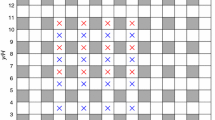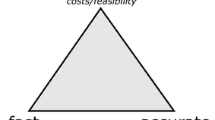Abstract
This study investigates flow variability at different scales and its effects on the dispersion of a passive scalar in a regular street network by means of direct numerical simulations (DNS), and compared to wind tunnel (WT) measurements. Specific scientific questions addressed include: (i) sources of variability in the flow at street-network scale, (ii) the effects of such variability on both puff and continuous localised releases, (iii) additional sources of uncertainty related to experimental setups and their consequences. The street network modelled here consists of an array of rectangular buildings arranged uniformly and with periodic horizontal boundary conditions. The flow is driven by a body force at an angle of 45 degrees relative to the streets in the network. Sources of passive scalars were located near ground level at three different types of locations: a short street, an intersection between streets and a long street. Flow variability is documented at different scales: small-scale intra-street variations linked with local flow topology; inter-street flow structure differences; street-network scale variability; and larger-scale spatial variations associated with above-canopy structures. Flow statistics and the dispersion behaviour of both continuous and short-duration (puff) releases of a passive scalar in the street network are analysed and compared with the results of wind-tunnel measurements. Results agree well with the experimental data for a source location in an intersection, especially for flow statistics and mean concentration profiles for continuous releases. Larger differences arise in the comparisons of puff releases. These differences are quantified by computing several puff parameters including time of arrival, travel time, rise and decay times. Reasons for the differences are discussed in relation to the underlying flow variability identified, differences between the DNS and WT setup and uncertainties in the experimental setup. Implications for the propagation of short-duration releases in real urban areas are discussed in the light of our findings. In particular, it is highlighted that in modelling singular events such as accidental releases, characterising uncertainties is more meaningful and useful than computing ensemble averages.

















Similar content being viewed by others
References
Andronopoulos S, Bartzis JG, Efthimiou GC, Venetsanos AG (2019) Assessment of puff-dispersion variability through Lagrangian and Eulerian modelling based on the JU2003 Campaign. Bound-Layer Meteorol 171(3):395–422
Belcher S, Coceal O, Goulart E, Rudd A, Robins A (2015) Processes controlling atmospheric dispersion through city centres. J Fluid Mech 763:51–81
Branford S, Coceal O, Thomas T, Belcher S (2011) Dispersion of a point-source release of a passive scalar through an urban-like array for different wind directions. Bound-Layer Meteorol 139(3):367–394
Carpentieri M, Robins AG (2015) Influence of urban morphology on air flow over building arrays. J Wind Eng Ind Aerodyn 145:61–74
Castro IP, Xie ZT, Fuka V, Robins AG, Carpentieri M, Hayden P, Hertwig D, Coceal O (2017) Measurements and computations of flow in an urban street system. Bound-Layer Meteorol 162(2):207–230
Cezana F, Goulart E, Reis N, Coceal O (2021) Analysis of pollutant entrainment from localized sources in a street network. Bound-Layer Meteorol 179(2):241–258
Coceal O, Thomas T, Castro I, Belcher S (2006) Mean flow and turbulence statistics over groups of urban-like cubical obstacles. Bound-Layer Meteorol 121(3):491–519
Coceal O, Dobre A, Thomas T, Belcher S (2007a) Structure of turbulent flow over regular arrays of cubical roughness. J Fluid Mech 589:375–409
Coceal O, Thomas TG, Belcher SE (2007b) Spatial variability of flow statistics within regular building arrays. Bound-Layer Meteorol 125(3):537–552
Coceal O, Goulart EV, Branford S, Thomas TG, Belcher SE (2014) Flow structure and near-field dispersion in arrays of building-like obstacles. J Wind Eng Ind Aerodyn 125:52–68
Ferziger JH, Perić M, Street RL (2019) Computational methods for fluid dynamics. Springer, Berlin
Fuka V, Xie ZT, Castro IP, Hayden P, Carpentieri M, Robins AG (2018) Scalar fluxes near a tall building in an aligned array of rectangular buildings. Bound-Layer Meteorol 167(1):53–76
Goulart EV, Coceal O, Branford S, Thomas T, Belcher S (2016) Spatial and temporal variability of the concentration field from localized releases in a regular building array. Bound-Layer Meteorol 159(2):241–257
Goulart EV, Coceal O, Belcher SE (2018) Dispersion of a passive scalar within and above an urban street network. Bound-Layer Meteorol 166(3):351–366
Hertwig D, Soulhac L, Fuka V, Auerswald T, Carpentieri M, Hayden P, Robins A, Xie ZT, Coceal O (2018) Evaluation of fast atmospheric dispersion models in a regular street network. Environ Fluid Mech 18(4):1007–1044
Michioka T, Funaki R, Kawai T (2023) Effects of building arrays on large-scale turbulent motions within an urban canopy. Bound-Layer Meteorol 186(3):693–710. https://doi.org/10.1007/s10546-022-00778-7
Moin P, Mahesh K (1998) Direct numerical simulation: a tool in turbulence research. Annu Rev Fluid Mech 30(1):539–578. https://doi.org/10.1146/annurev.fluid.30.1.539
Wood CR, Arnold SJ, Balogun AA, Barlow JF, Belcher SE, Britter RE, Cheng H, Dobre A, Lingard JJ, Martin D et al (2009) Dispersion experiments in central london: the 2007 dapple project. Bull Am Meteor Soc 90(7):955–970
Yao Y, Thomas T, Sandham N, Williams J (2001) Direct numerical simulation of turbulent flow over a rectangular trailing edge. Theoret Comput Fluid Dyn 14:337–358
Acknowledgements
The DIPLOS project was funded by the UK’s Engineering and Physical Sciences Research Council grants EP/K040707/1 (Reading; DNS work) and EP/K040731/1 (Surrey; wind-tunnel work). Karine Klippel, Elisa V. Goulart and Neyval Costa Reis Junior gratefully acknowledge funding from National Council for Scientific and Technological Development (CNPq), Capes (Coordination of Superior Level Staff Improvement) - Print Institutional Internationalization Program (88881.311735/2018-01.) and Espirito Santo Research Foundation (FAPES), Brazil. Omduth Coceal gratefully acknowledges funding from NERC under the ASSURE project (Contract No. NE/W002965/1).
Author information
Authors and Affiliations
Contributions
TA and TGT performed the numerical simulations. MC and PH conducted the wind tunnel experiments. AR managed the wind tunnel experiments. KK analysed the data and wrote the first draft of the manuscript. DH contributed with ideas and the manuscript revision. EVG, NCR, TA and OC supervised KK’s analyses and writing of the manuscript. OC managed the DIPLOS project and contributed to writing the final draft. All authors reviewed the manuscript.
Corresponding author
Ethics declarations
Conflict of interest
The authors declare no Conflict of interest.
Additional information
Publisher's Note
Springer Nature remains neutral with regard to jurisdictional claims in published maps and institutional affiliations.
Rights and permissions
Springer Nature or its licensor (e.g. a society or other partner) holds exclusive rights to this article under a publishing agreement with the author(s) or other rightsholder(s); author self-archiving of the accepted manuscript version of this article is solely governed by the terms of such publishing agreement and applicable law.
About this article
Cite this article
Auerswald, T., Klippel, K., Thomas, T.G. et al. Effect of Flow Variability on Dispersion of Continuous and Puff Releases in a Regular Street Network. Boundary-Layer Meteorol 190, 20 (2024). https://doi.org/10.1007/s10546-024-00863-z
Received:
Accepted:
Published:
DOI: https://doi.org/10.1007/s10546-024-00863-z




